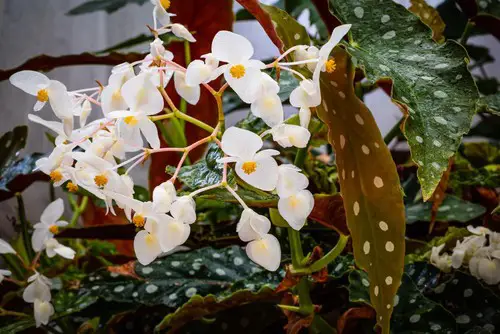Angel wing begonias are popular houseplants that are known for their unique wing-shaped foliage and colorful flowers. However, if you notice your Angel wing begonia leaves turning brown, it can be a cause for concern.
Brown leaves are a sign that something is wrong with your plant, and it’s important to figure out the cause so that you can take appropriate action.
Understanding angel wing begonia is the first step to diagnosing and treating brown leaves. These plants are native to tropical regions and prefer warm, humid environments with bright, indirect light. They also require well-draining soil and regular watering. If any of these conditions are not met, your plant may develop brown leaves.
There are several common problems that can cause brown leaves in angel wing begonia, including diseases, pests, and environmental factors. Diagnosing the cause of brown leaves can be tricky, but by examining the plant and considering its growing conditions, you can narrow down the possibilities.
In the following sections, we will explore the various causes of brown leaves in angel wing begonia and discuss how to prevent and treat this issue.
Key Takeaways
- Brown leaves in angel wing begonia can be a sign of a problem with the plant.
- Understanding the growing conditions and common problems of angel wing begonia is crucial for diagnosing and treating brown leaves.
- Diagnosing the cause of brown leaves can be challenging, but with careful observation and consideration of the plant’s environment, it is possible to identify the issue and take appropriate action.
Understand why these other popular houseplants turn brown:
Understanding Angel Wing Begonia
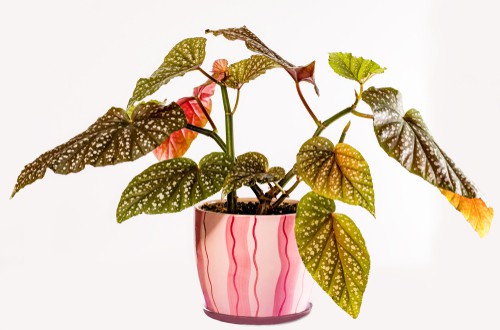
Angel Wing Begonia, also known as cane begonia or Begonia corallina, is a popular flowering houseplant that is loved for its stunning foliage and beautiful blooms. It is native to tropical and subtropical regions of South America and is a member of the Begoniaceae family.
One of the most distinctive features of the Angel Wing Begonia is its wing-shaped leaves, which are often spotted or variegated. The leaves can range in color from green to silver and even pink or red. The plant also produces clusters of delicate, pendulous flowers in shades of pink, red, or white.
Angel Wing Begonia is a relatively easy plant to care for, making it a popular choice for both novice and experienced gardeners. It thrives in bright, indirect light and prefers well-draining soil that is kept consistently moist. However, overwatering can lead to root rot and cause the leaves to turn brown.
It is important to note that there are many different varieties of Angel Wing Begonia, each with its own unique characteristics. Some varieties, such as the Begonia corallina, have larger leaves and produce larger blooms, while others have smaller leaves and produce more delicate flowers.
Angel Wing Begonia Leaves Turning Brown – 4 Common Problems
Angel Wing Begonia is a popular houseplant that is relatively easy to care for. However, like all plants, it can suffer from a variety of problems that can cause its leaves to turn brown, yellow, or wilt. Some common problems with Angel Wing Begonia are discussed below.
1. Overwatering
Overwatering is a common problem with Angel Wing Begonia that can cause its leaves to turn brown or yellow. When the plant is overwatered, its roots become waterlogged, which can lead to root rot.
This can cause the plant to wilt, and its leaves may turn brown or yellow. To avoid overwatering, make sure that the plant’s soil is well-draining and that it is not sitting in standing water.
2. Low Temperatures
Angel Wing Begonia prefers warm temperatures and can suffer if exposed to low temperatures. When the plant is exposed to temperatures below 50°F (10°C), its leaves may turn brown or yellow and may eventually drop off. To prevent this, make sure that the plant is kept in a warm location and is not exposed to cold drafts.
3. Lack of Humidity
Angel Wing Begonia prefers high humidity levels and can suffer if the air is too dry. When the air is too dry, the plant’s leaves may turn brown or yellow and may become crispy. To prevent this, you can mist the plant’s leaves with water or place a humidifier near the plant to increase the humidity levels.
4. Pests
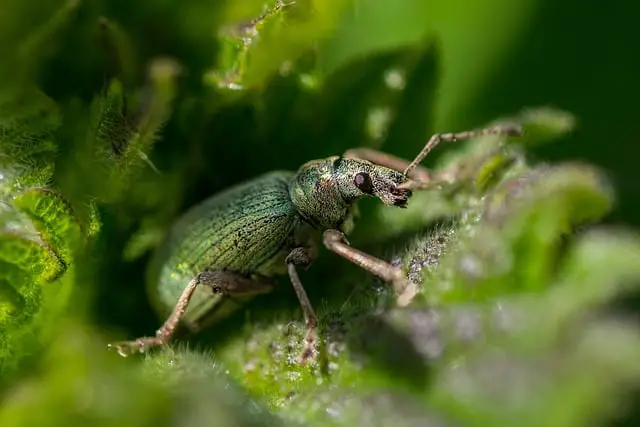
Pests can also be a problem with Angel Wing Begonia and can cause its leaves to turn brown or yellow. Common pests that can infest Angel Wing Begonia include spider mites, mealybugs, and scale insects. To prevent pest infestations, you can regularly inspect the plant’s leaves for signs of pests and treat any infestations promptly.
Diagnosing Brown Leaves
If you notice the leaves of your angel wing begonia turning brown, it can be concerning. However, it’s not always a sign of a serious problem. Brown leaves can be caused by a variety of factors, some of which are easily remedied. Here are some tips for diagnosing the cause of brown leaves on your angel wing begonia.
1. Underwatering
One common cause of brown leaves is underwatering. When a plant doesn’t receive enough water, its leaves can turn brown and crispy. To check if your angel wing begonia is underwatered, feel the soil. If it’s dry to the touch, it’s time to water the plant. However, be careful not to overwater, as this can also cause brown leaves.
2. Overwatering
Overwatering can also cause brown leaves on an angel wing begonia. When a plant receives too much water, its roots can become waterlogged, which can lead to root rot. This can cause the leaves to turn brown and yellow, and the plant may also have a foul odor.
To avoid overwatering, make sure the soil has proper drainage and only water the plant when the top inch of soil feels dry.
3. Low Temperatures
Low temperatures can cause permanent damage to your angel wing begonia and lead to brown leaves. Temperatures below 55 degrees Fahrenheit (12 degrees Celsius) can be detrimental to the plant’s health.
To ensure that your plant thrives, it needs temperatures of around 65-75 degrees Fahrenheit (18-24 degrees Celsius) year-round. Keep your angel wing begonia away from cold drafts and windows during the winter months.
4. Pests and Diseases
Pests and diseases can also cause brown leaves on an angel wing begonia. Spider mites, mealybugs, and thrips are common pests that can cause brown leaves. Fungal diseases such as leaf spot and powdery mildew can also cause brown spots on leaves.
If you suspect that your plant has a pest or disease problem, isolate it from other plants and treat it accordingly.
5. Nutrient Deficiencies
Nutrient deficiencies can cause yellow halos or white patches on the leaves of an angel wing begonia, which can eventually turn brown. If you suspect that your plant has a nutrient deficiency, consider fertilizing it with a balanced fertilizer. However, be careful not to over-fertilize, as this can also cause brown leaves.
Diseases Causing Brown Leaves

Begonia plants are susceptible to various diseases that can cause the leaves to turn brown. Identifying the root cause of the browning leaves is crucial in determining the appropriate treatment to restore the plant’s health and beauty. Here are some of the common diseases that can cause begonia leaves to turn brown:
1. Bacterial Leaf Spot
Bacterial leaf spot is caused by bacteria that infect the leaves of the plant. The bacteria cause the leaves to turn brown and eventually die. The infected leaves may have yellow halos around the brown spots.
To prevent bacterial leaf spot, avoid overhead watering and provide adequate ventilation to reduce humidity levels. Remove infected leaves and destroy them to prevent the spread of the disease.
2. Fungal Leaf Spot
Fungal leaf spot is caused by various fungi that infect the leaves of the plant. The infected leaves may have brown spots with yellow halos. The disease can spread rapidly, especially in humid conditions. To prevent fungal leaf spot, avoid overhead watering, provide adequate ventilation, and remove infected leaves. Fungicides may be used to control the disease.
3. Powdery Mildew
Powdery mildew is a fungal disease that can cause white or gray powdery patches on the leaves, stems, and flowers of the plant. The infected leaves may also turn brown and dry out. To prevent powdery mildew, provide adequate air circulation, avoid overhead watering, and remove infected leaves. Fungicides may also be used to control the disease.
4. Root Rot
Root rot is caused by various pathogens, including fungi, that infect the roots of the plant. The infected roots may turn brown and mushy, and the leaves may turn yellow or brown and wilt. To prevent root rot, avoid overwatering and provide well-draining soil. Infected plants should be removed and destroyed to prevent the spread of the disease..
Pests Affecting Angel Wing Begonia

Angel Wing Begonias are prone to a number of pests that can cause damage to the plant, including thrips, mealybugs, and spider mites. These pests can cause the leaves to turn brown and eventually fall off, which can be a sign of a serious infestation.
Thrips are small, winged insects that feed on the leaves of plants. They can cause damage to the leaves by puncturing them and sucking out the sap. This can cause the leaves to turn brown and curl up. Thrips can be difficult to control, but they can be managed by using insecticidal soap or neem oil.
Mealybugs are soft-bodied insects that feed on the sap of plants. They can be identified by their white, cotton-like appearance. Mealybugs can cause the leaves to turn brown and wilt, and they can also cause the plant to become stunted. Mealybugs can be controlled by using insecticidal soap or neem oil.
Spider mites are tiny, spider-like insects that feed on the leaves of plants. They can be identified by the fine webbing they produce on the leaves. Spider mites can cause the leaves to turn brown and dry out, and they can also cause the plant to become stunted. Spider mites can be controlled by using insecticidal soap or neem oil.
It is important to monitor your Angel Wing Begonia regularly for signs of pest infestation and to take action as soon as possible to prevent further damage. Regularly inspecting the leaves and using natural pest control methods can help keep your plant healthy and thriving.
Role of Light in Leaf Browning
Angel Wing Begonias require bright, indirect light to thrive. Direct sunlight can cause the leaves to turn brown and dry out, while too little light can result in leggy growth and small leaves. Therefore, it is essential to provide the plant with the right amount of light to prevent leaf browning.
If the plant is placed in a location with too much direct sun, the leaves can get sunburned, which can cause them to turn brown and crispy. Therefore, it is best to place the plant in an area with bright, indirect light. If the plant is near a window, it is best to place it in an east-facing window, where it can get morning sun but avoid the intense afternoon sun.
If the plant is not getting enough light, it can also cause the leaves to turn brown. In such cases, it is best to move the plant to a brighter location or supplement with artificial plant lights. These lights can provide the plant with the right amount of light to prevent leaf browning.
In summary, the role of light in leaf browning is crucial for the health of Angel Wing Begonias. Providing the plant with bright, indirect light and avoiding direct sunlight can prevent leaf browning and ensure the plant thrives.
Watering Practices for Healthy Leaves
One of the most important factors in maintaining healthy angel wing begonia leaves is proper watering practices. Overwatering, underwatering, and improper watering frequency can all lead to brown leaves and other issues.
To ensure healthy leaves, it is important to monitor the soil moisture level regularly. Angel wing begonias prefer moist but well-draining soil, so it is important to avoid soggy soil. One way to do this is to ensure that the pot has adequate drainage holes to allow excess water to escape.
It is recommended to water the plant when the top inch of soil feels dry to the touch. This can vary based on factors such as the temperature and humidity levels in the room, so it is important to monitor the soil moisture level regularly.
Overwatering can lead to brown leaves and other issues, so it is important to avoid watering the plant too frequently or allowing the soil to become waterlogged. Signs of overwatering include yellowing leaves and a mushy or rotten smell coming from the soil.
Underwatering can also lead to brown leaves, so it is important to ensure that the plant is receiving enough water. Signs of underwatering include crispy brown leaves and a dry, dusty soil surface.
In summary, proper watering practices are crucial for maintaining healthy angel wing begonia leaves. Monitoring soil moisture levels, ensuring proper drainage, avoiding overwatering and underwatering, and watering the plant when the top inch of soil feels dry can all help prevent brown leaves and other issues.
Importance of Soil and Potting Mix
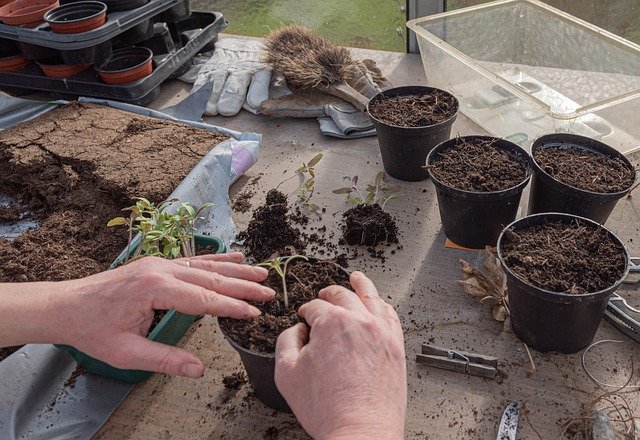
Angel Wing Begonias are sensitive to the quality of soil and potting mix they are grown in. The right soil mix is essential for the plant to thrive, and it can make a big difference in preventing brown leaves.
The ideal soil mix for Angel Wing Begonias should be well-draining, yet moisture-retentive. A mix of peat moss, perlite, and vermiculite is often recommended. Peat moss helps to retain moisture, while perlite and vermiculite improve drainage.
When planting an Angel Wing Begonia, it is important to use a pot that is the right size. Small pots or containers can cause the soil to dry out too quickly, leading to brown leaves. A pot that is too large can cause the soil to stay too moist, which can lead to root rot. A pot that is just slightly larger than the root ball is ideal.
It is also important to repot Angel Wing Begonias every year or two. Over time, the soil can become compacted, which can prevent water and nutrients from reaching the roots. Repotting gives the plant fresh soil and more room to grow.
When repotting, it is important to use a fresh potting mix. Old potting mix can become depleted of nutrients and may not drain as well as fresh mix. A high-quality potting mix that is specifically formulated for houseplants is recommended.
Temperature and Humidity Factors
Angel wing begonias thrive in moderate temperatures and humidity levels. They prefer temperatures between 60-85°F (15-29°C) and moderate humidity levels between 40-60%. High humidity can encourage fungal growth and low humidity can cause the leaves to turn brown and crispy.
To maintain the ideal humidity levels, it is recommended to use a humidifier or mist the leaves regularly. Alternatively, a homemade humidity tray can be made by placing pebbles and water in a tray and placing the plant on top. This will help to increase the humidity levels around the plant.
It is important to note that while angel wing begonias prefer moderate humidity levels, they do not tolerate standing water. Overwatering can cause root rot and lead to brown leaves. Therefore, it is important to ensure that the soil is well-draining and not waterlogged.
In addition to humidity, temperature also plays a crucial role in the health of the plant. Sudden changes in temperature can cause stress to the plant and lead to brown leaves. It is important to keep the plant away from drafts and to avoid placing it near air conditioning units or heating vents.
Overall, maintaining moderate humidity levels and consistent temperatures is key to preventing brown leaves on angel wing begonias. Using a humidifier, misting, or a homemade humidity tray can help to increase humidity levels, while avoiding overwatering and sudden temperature changes can help to keep the plant healthy and thriving.
Proper Care and Maintenance
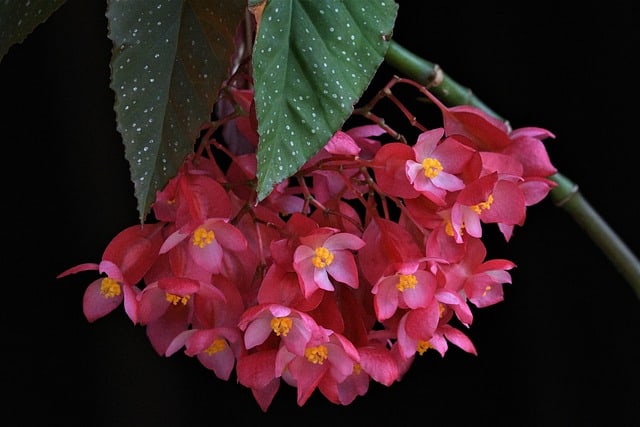
Angel wing begonias are relatively easy to care for, but they do require proper care and maintenance to thrive. Here are some tips to keep your plant healthy and looking its best:
1. Watering
One of the most important aspects of angel wing begonia care is proper watering. These plants prefer moist soil, but they can be prone to root rot if they are overwatered. It is best to water thoroughly when the top inch of soil feels dry to the touch. Be sure to allow excess water to drain away, and never let the plant sit in standing water.
2. Light
Angel wing begonias prefer bright, indirect light. They can tolerate some direct sunlight, but too much can scorch their leaves. If your plant is not getting enough light, you may notice that the leaves are turning brown around the edges.
3. Fertilizer
Angel wing begonias benefit from regular fertilization during the growing season. Use a balanced plant fertilizer every two to four weeks, following the manufacturer’s instructions. Be sure to water the plant thoroughly before and after fertilizing to prevent root burn.
4. Pruning
Regular pruning can help keep your angel wing begonia looking neat and tidy. Remove any dead or yellowing leaves as soon as you notice them, and trim back any leggy or overgrown stems. You can also take stem cuttings to propagate new plants.
5. Appearance
If you notice that your angel wing begonia leaves are turning brown, it may be a sign that the plant is not getting the proper care and maintenance it needs. Check the soil moisture, light levels, and fertilizer schedule to ensure that everything is in order. With a little attention, your plant should recover and start thriving again.
Preventing Brown Leaves in Angel Wing Begonia
Angel Wing Begonias are beautiful plants that can add a touch of elegance to any home. However, one common problem that many growers face is brown leaves. Fortunately, there are several ways to prevent brown leaves in Angel Wing Begonia.
1. Proper Watering

One of the most important things to keep in mind when growing Angel Wing Begonias is proper watering. Overwatering can cause root rot, which can lead to brown leaves. On the other hand, underwatering can cause the leaves to dry out and turn brown.
To prevent brown leaves, it is important to water the plant when the soil is dry to the touch. It is also important to ensure that the pot has good drainage to prevent water from accumulating at the bottom of the pot.
2. Air Circulation
Another important factor in preventing brown leaves in Angel Wing Begonia is air circulation. Poor air circulation can cause the leaves to become damp, leading to fungal growth and brown spots.
To prevent this, it is important to place the plant in an area with good air circulation. This can be achieved by placing a fan nearby or by opening windows to allow fresh air to circulate.
3. Filtered Sunlight
Angel Wing Begonias thrive in bright, indirect sunlight. However, direct sunlight can cause the leaves to burn and turn brown. To prevent this, it is important to place the plant in an area with filtered sunlight.
This can be achieved by placing the plant near a window with a sheer curtain or by placing it in a room with bright, indirect light.
4. Edema
Edema is a condition that occurs when the plant absorbs more water than it can use. This can cause the leaves to swell and turn brown.
To prevent edema, it is important to avoid overwatering the plant. It is also important to ensure that the plant is not exposed to high humidity, as this can exacerbate the condition.
In conclusion, preventing brown leaves in Angel Wing Begonia requires proper watering, good air circulation, filtered sunlight, and avoiding edema. By following these tips, growers can enjoy healthy, beautiful plants that will add a touch of elegance to any home.
Final Thoughts on Angel Wing Begonia Care
Angel Wing Begonias are a popular choice for indoor and outdoor gardeners alike due to their beautiful foliage and easy care requirements. However, even the most experienced growers may encounter issues with their begonias, such as brown leaves.
While there are several reasons why the leaves may turn brown, proper care can prevent many of these issues.
One of the most important factors in caring for Angel Wing Begonias is ensuring they receive sufficient light. These plants thrive in bright, indirect light and should be placed near a window that receives plenty of natural light. However, direct sunlight can scorch their leaves, so it is important to avoid placing them in direct sunlight.
In addition to light, proper watering is crucial for the health of these plants. Angel Wing Begonias like to be kept consistently moist, but not overly wet. Overwatering can lead to root rot and other issues, while underwatering can cause the leaves to turn brown and dry out.
To prevent these issues, water the plant thoroughly when the top inch of soil feels dry to the touch.
Another important aspect of Angel Wing Begonia care is fertilization. These plants benefit from regular feeding during the growing season, which typically runs from spring to fall. A balanced, water-soluble fertilizer can be applied every two to four weeks to promote healthy growth and vibrant foliage.
Finally, it is important to keep an eye out for pests and diseases that can affect Angel Wing Begonias. Common pests include spider mites, mealybugs, and scale insects, while diseases such as powdery mildew and botrytis can also occur. Regularly inspecting the plant and treating any issues promptly can help prevent brown leaves and other problems.
Frequently Asked Questions
Why is my angel wing begonia turning brown?
Angel wing begonias can turn brown due to several reasons, including overwatering, underwatering, too much sunlight, low humidity, and fungal or bacterial diseases. It’s essential to identify the root cause of the problem to take appropriate action and prevent further damage.
Should I cut off brown begonia leaves?
It’s recommended to trim off brown begonia leaves to prevent the spread of disease and maintain the plant’s appearance. However, it’s essential to use sterile pruning tools and avoid cutting off healthy leaves.
Why are my angel wing begonia leaves crispy?
Crispy angel wing begonia leaves can be a sign of underwatering. When the plant doesn’t receive enough water, the leaves start to dry out, become crispy, and eventually turn brown. It’s crucial to water the plant adequately and maintain consistent moisture levels.
What do overwatered begonias look like?
Overwatered begonias can have yellowing leaves, wilting, and mushy stems. The soil may also smell sour or musty, indicating root rot. It’s crucial to reduce watering and improve drainage to prevent further damage.
Why are my yellow begonia flowers turning brown?
Yellow begonia flowers can turn brown due to age or environmental stress. However, it can also be a sign of fungal or bacterial diseases. It’s essential to monitor the plant’s overall health and take appropriate action to prevent further damage.
What causes brown spots on begonia leaves?
Brown spots on begonia leaves can be a sign of fungal or bacterial diseases, environmental stress, or insect infestations. It’s crucial to identify the root cause and take appropriate action to prevent further damage.

Hey, I’m Lisa and I’ve been an avid gardener for over 30 years. I love writing, talking and living in the garden! Feel free to connect with me on my socials below

